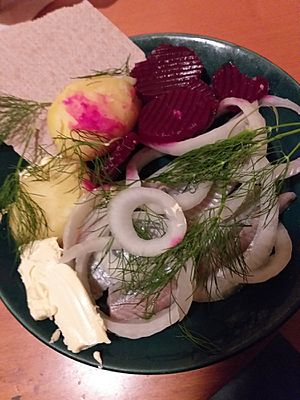Spekesild facts for kids
Spekesild is a special type of herring that has been preserved using lots of salt. The name "Spekesild" comes from the Norwegian words for "raw herring pickled in salt." It's a traditional food in Norway and other parts of Northern Europe.
Contents
How Spekesild is Made
Salt Curing Process
Making spekesild involves a process called salt curing. This means the herring is covered in salt. The salt works like a sponge, pulling water out of the fish. When the water is removed, tiny living things called microbes can't grow well. This stops the fish from spoiling and helps it last a long time without needing a refrigerator.
Preparing to Eat
Before you can eat salted herring, you need to prepare it. The fish is usually soaked in fresh water. This process, called desalination, removes some of the extra salt. It usually takes about one and a half to two hours to get the fish ready.
Spekesild in History
For hundreds of years, spekesild was a very important food in Norway. It was often called "poor man's diet" because it was cheap and easy to store. This salted fish helped many people avoid hunger, especially during long winters.
A Traditional Norwegian Dish
Today, spekesild is still a popular dish. A classic Norwegian meal with salted herring often includes boiled potatoes. People also add raw onions and fresh dill. Other common sides are pickled beetroots and butter or creme fraiche. It's often served with flatbrød, a type of thin, crispy bread.
Export and Trade
For a long time, herring was a major export for Norway. It was sent to many other countries. While the amount of herring caught changed over the years, spekesild remains a valued product. Today, countries like Russia, Sweden, and Poland are important places where Norwegian spekesild is sold.


